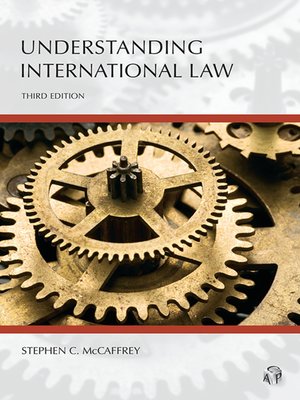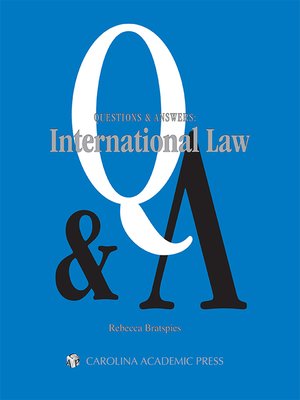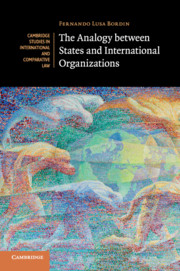Course Info
An introduction to basic comparative, transnational, and international law disciplines. Using areas of substantive and procedural law familiar to first-year students, the course examines issues arising from cross-national activity. Students are exposed to choice of law, comparative law, international law, and international institutions.
Instructor

Prof. Avidan Cover is the Associate Dean for Academic Affairs and the Director of the Institute for Global Security Law and Policy for the Frederick K. Cox International Law Center at Case Western Reserve University School of Law. He teaches International Law; International Human Rights Law; and a Race, Law and Society seminar.
Syllabus
The syllabus for your course is available on Canvas.
Textbook
Study Aids
These study aids are available online. Please click the hyperlinked title to view them. For instructions on how to use the specific platforms, including troubleshooting, please view Andy Dorchak's Study Aids Research Guide.
 Understanding International Law by ISBN: 9781531019662Publication Date: 2021Available via LexisNexis Digital Library
Understanding International Law by ISBN: 9781531019662Publication Date: 2021Available via LexisNexis Digital Library Questions & Answers: International Law by ISBN: 978422417768Publication Date: 2011Available via LexisNexis Digital Library
Questions & Answers: International Law by ISBN: 978422417768Publication Date: 2011Available via LexisNexis Digital LibraryPrinciples of International Law by
ISBN: 9781683286776Publication Date: 2018-08-20Available via West Academic Study Aids.Public International Law in a Nutshell by
ISBN: 9781683282396Publication Date: 2018-10-17Available via West Academic Study Aids. Examples and Explanations for International Law by ISBN: 9781454851622Publication Date: 2014-10-30Available via Aspen Learning Library.
Examples and Explanations for International Law by ISBN: 9781454851622Publication Date: 2014-10-30Available via Aspen Learning Library.Emanuel Law Outlines for International Law by
ISBN: 9781543817034Publication Date: 2019-12-26Available via Aspen Learning Library.
CALI
Computer-Aided Legal Instruction (CALI) requires an authorization code to use. If you do not have a CALI account, please contact Kieran Layton or the reference desk for assistance.
Quimbee
If you have not registered your Quimbee account, please contact Kieran Layton or the reference desk for assistance.
Audio Guides
Sum and Substance Audio on International Law by
Publication Date: 2020Available via West Academic Study Aids. International Law: In Other Words Audio Series by ISBN: 9781543823912Publication Date: 2/6/2020Available via Aspen Learning Library.
International Law: In Other Words Audio Series by ISBN: 9781543823912Publication Date: 2/6/2020Available via Aspen Learning Library.
Researching International Law
International Law & the U.S.
- Restatement, Foreign Relations of the United Statesvia HeinOnline (also available via Lexis or Westlaw)
Selected Databases
- Max Planck Encyclopedias of International LawThis resource is technically the online edition of a large multi-volume encyclopedia. However, the scope and quality of this resource are sufficiently unique to set it apart as an extremely valuable online starting point for any research in public international law topics and Oxford University Press treats it as a database. This is published in partnership with Germanys Max Planck Institute for Comparative Public Laws and International Law.
- HeinOnlineThe HeinOnline platform provides numerous online collections of legal source material, and provides both page-image (as pdf files) copies for retrieval and display of cited works and full-text page images. Use the Comprehensive User's guide to learn about special features such as Scholar Check or retrieving case law from Fastcase by clicking on inline hyperlinks throughout HeinOnline documents. A premiere online database containing more than 200,000 titles, including law reviews and journals, government documents, classic legal treatises, and more.
- World Treaty Library (HeinOnline)This is probably the most comprehensive collection of treaties (formal international agreements) that is currently available.
- Index to Legal Periodicals and BooksThis is the premier index of legal periodicals, books, and sympoisa, with a primary focus on English language resources. Many articles are available in full-text. Some articles may be available via HeinOnline. (1981-Present)
- Legal CollectionLegal Collection includes full text for nearly 250 of the world's scholarly law journals, including a mix of law-school based journals, peer-reviewed journals, bar journals, and other genres of legal literature. Provides index, abstracts and selected full text.
- China Legal Knowledge Database (CLKD) Chinese InterfaceChina Legal Knowledge Database (CLKD) is part of the China National Knowledge Infrastructure (CNKI), launched in late 2010. Its content is officially sanctioned by the People's Republic of China. Content includes: Laws/regulations from 1949 to date (500,000 records); Cases from 1979 to date (230,000 records); and Secondary Sources: (1.5 million records). The database is updated daily and newly enacted laws are provided within 48 hours. Both primary and secondary resources cover over 400 legal topics. Includes an English-Chinese dictionary. (English search interface)
- China Law Info (CLI)Chinalawinfo.com (CLI) (also known as PKUlaw.cn) is the Chinese-language version of the Chinese legal information system launched by Peking University in 1985. It provides complete access to China's primary and secondary legal materials. (Coverage is more extensive than lawinfochina.com (LIC), the English-language version).
- China Academic JournalsChina Academic Journals is a full-text database covering over 7000 journals published in China. The content includes law and social sciences among many other topics. Covers from 1915 onward.
- Academic Search Complete Indexes thousands of journals from multiple disciplines and also includes full text (pdf) of a substantial subset of those. On the EBSCOhost platform.
Selected Books
The Oxford Handbook of the Sources of International Law
The question of the sources of international law inevitably raises some well-known scholarly controversies: where do the rules of international law come from? And more precisely: through which processes are they made, how are they ascertained, and where does the international legal order beginand end? These traditional questions bear on at least two different levels of understanding. First, how are international norms validated as rules of international "law", i.e. legally binding norms? This is the static question of the pedigree of international legal rules and the boundaries of theinternational legal order. Second, what are the processes through which these rules are made? This is the dynamic question of the making of these rules and of the exercise of public authority in international law.The Oxford Handbook of the Sources of International Law is the very first comprehensive work of its kind devoted to the question of the sources of international law. It provides an accessible and systematic overview of the key issues and debates around the sources of international law. It alsooffers an authoritative theoretical guide for anyone studying or working within but also outside international law wishing to understand one of its most foundational questions. This handbook features original essays by leading international law scholars and theorists from a range of traditions,nationalities and perspectives, reflecting the richness and diversity of scholarship in this area.
Treaty Interpretation and the Vienna Convention on the Law of Treaties: 30 Years On
Interpretation has always been a cornerstone of international adjudication. This book offers a comprehensive analysis, both on a theoretical and a practical level, of where the principles of interpretation enshrined in Articles 31-33 of the VCLT currently stand.
Vienna Convention on the Law of Treaties
The Commentary on the Vienna Convention on the Law of Treaties provides an in-depth article-by-article analysis of all provisions of the Vienna Convention. The texts are uniformly structured: (I) Purpose and Function of the Article, (II) Historical Background and Negotiating History, and (III) Elements of the Article. The Vienna Convention on Treaties between States and IOs and between IOs is taken into account where appropriate. In sum, the present Commentary contains a comprehensive legal analysis of all aspects of the international law of treaties. Where the law of treaties reaches into other fields of international law, e.g. the law of state responsibility, the relevant interfaces are discussed and contextualized. With its focus on international practice, the Commentary is addressed to academia, as well as to practitioners of international law.
Jus Cogens
The doctrine of peremptory norms (jus cogens) is a set of core obligations in international law. In this volume in the Elements of International Law series, Dinah Shelton explores its origins and history, its revival in the twentieth century, and its place in international and domesticjurisprudence. Providing a fresh, objective, and non-argumentative approach to the discipline of international law, the Elements series is an accessible go-to source for practicing international lawyers, judges and arbitrators, government and military officers, scholars, teachers, and students.Beginning with the writings of Grotius, Vattel, and Suarez, Shelton shows how the theory of jus cogens drew upon Roman law for its foundations. In the subsequent chapter, she considers the emergence of positivism and its rejection of any non-consensual basis for binding States to internationalnorms. She then turns to the re-emergence of jus cogens in theories of the twentieth century and its place in the modern law of treaties. The volume includes extensive analysis of the interpretation of jus cogens obligations by international courts and tribunals, as well as by various domesticcourts, including those of Italy, Greece, Canada, the US, and the UK. The volume concludes with a consideration of the place of jus cogens in modern scholarship.
Jus Cogens
One of the most complex doctrines in contemporary international law, jus cogens is the immediate product of the socialization of the international community following the Second World War. However, the doctrine resonates in a centuries-old legal tradition which constrains the dynamics of voluntarism that characterize conventional international law. To reconcile this modern iteration of individual-oriented public order norms with the traditionally state-based form of international law, Thomas Weatherall applies the idea of a social contract to structure the analysis of jus cogens into four areas: authority, sources, content and enforcement. The legal and political implications of this analysis give form to jus cogens as the product of interrelation across an individual-oriented normative framework, a state-based legal order, and values common to the international community as a whole.
Peremptory International Law - Jus Cogens
Robert Kolb, one of the leading international scholars of his generation, offers a seminal survey of the question of peremptory international law. The author analyses and systemises different questions, such as: the typology of peremptory norms beyond the Vienna Convention on the Law of Treaties; here he distinguishes between 'public order' jus cogens and mere 'public utility' jus cogens. Furthermore, what about relative jus cogens, such as regional jus cogens norms or conventional jus cogens norms? What about some consequences of jus cogens breaches in the law of State responsibility: are they themselves jus cogens? Thus, can individual war reparations be renounced by lump-sum agreements? What happens if different jus cogens norms are in conflict? Is there a difference between the scope of jus cogens in inter-State relations and its scope for other subjects of law, such as the UN and its Security Council? Is jus cogens necessarily predicated on the concept of a hierarchy of norms? What is the exact extent of the peremptory nature of some rules? Sometimes, only the core of a principle is peremptory, while its normative periphery is not. Also, in the use of force, the peremptory character of the provision is compatible with agreements falling under the recognised exceptions, such as collective self-defence. These and other unusual questions are discussed in the present book.
International Law in the US Legal System
International Law in the U.S. Legal System provides a wide-ranging overview of how international law intersects with the domestic legal system of the United States, and points out various unresolved issues and areas of controversy. Curtis Bradley explains the structure of the U.S. legal system and the various separation of powers and federalism considerations implicated by this structure, especially as these considerations relate to the conduct of foreign affairs. Against this backdrop, he covers all of the principal forms of international law: treaties, executive agreements, decisions and orders of international institutions, customary international law, and jus cogens norms. He also explores a number of issues that are implicated by the intersection of U.S. law and international law, such as treaty withdrawal, foreign sovereign immunity, international human rights litigation, war powers, extradition, and extraterritoriality. This book highlights recent decisions and events relating to the topic, including various actions taken during the Trump administration, while also taking into account relevant historical materials, including materials relating to the U.S. Constitutional founding. Written by one of the most cited international law scholars in the United States, the book is a resource for lawyers, law students, legal scholars, and judges from around the world.
International and Foreign Legal Research
International and Foreign Legal Research: A Coursebook emphasizes legal research strategies applicable across the landscape of research sources. Topics covered in the book range from a general chapter on basic concepts to five chapters on particular subjects of international law. Each major aspect of research, such as using periodical indexes, is treated once in depth. Elsewhere in the book, other sections refer readers to that in-depth treatment, while adding information specific to the topic being discussed. A companion website is also made available to help users of the book stay up-to-date on new sources and strategies.

The Analogy Between States and International Organizations
The book investigates how an analogy between States and international organizations has influenced and supported the development of the law that applies to intergovernmental institutions on the international plane. That is best illustrated by the work of the International Law Commission on the treaties and responsibility of international organizations, where the Commission for the most part extended to organizations rules that had been originally devised for States. Revisiting those codification projects while also looking into other areas, the book reflects on how techniques of legal reasoning can be - and have been - used by international institutions and the legal profession to tackle situations of uncertainty, and discusses the elusive position that international organizations occupy in the international legal system. By cutting across some foundational topics of the discipline, the book makes a substantive contribution to the literature on subjects and sources of international law.
The UN General Assembly
The United Nations General Assembly is arguably the most important discussion forum in global politics. This is a concise and accessible introduction to its history, organization and politics. Examining the development of the Assembly as a forum for improving international cooperation, this study details its development of shared norms and goals in the political context of the immediate post-World War II era. The Assembly has had to adapt quickly to the Cold War, the South-North contentions over development, the dissolution of the Soviet bloc and the rise in concern about terrorism. This study also presents a fascinating look ahead to three potential futures: a world of states, a world government, and a world of network governance. To flourish in any of these contexts it shows how the practices of the institution will require considerable change. The common criticisms of the Assembly are also covered in depth, such as that it is just a talking shop; that it is hamstrung by the Security Council and that it benefits the rich at the expense of the poor. This is an ideal book for students of the United Nations, international organizations and global governance.

